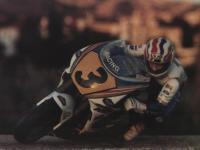 |
| Click on image, above, to get a 40kb, 800X600 wallpaper! |
| Here's how to convert this image to a Windows wallpaper |
 |
| This is how the rider moves. The mechanism is connected to the steering servo and via links it does a larger movement than the forks. The rider's head is connected to this system and moves accordingly. |
 |
The assembly is divided in 25 steps, which, if followed to the letter, should provide no problem.
It took us about two and a half hours to build the bike, without doing any painting or putting any of the almost 90 (!) stickers.
Modelling skill will be appreciated, but even an inexperienced model builder will have no real trouble, if he/she follows the instructions. Some special tools are given with the kit, such as an allen wrench for the single allen-screw, along with a cross-spanner which is used only for tightening the wheel axles. The extra tools you'll need are described in the first page of the assembly manual. I'll add to these a thin Phillips screwdriver, for the small 2X8 mm screws which hold the balls on the rider's arms and legs. The instructions are crystal-clear. I'll have to recommend you to be patient and not open all the small nylon bags together, but follow the instructions, which tell you in each step what exactly you'll need. |
| The naked frame looks almost like the real thing! But where's the V4?! |
 |
 |
| The LeMans DMC20BB is good for 20000 rpm, says Kyosho! |
The rear shock has adjustable spring preload, although it's very difficult to reach. |
 |
 |
| . | Old Model | New Model |
| Length | 270 mm | 270 mm |
| Width | 94 mm | 98 mm |
| Height | 184 mm | 190 mm |
| Weight | 680 gr | 750 gr |
| Wheelbase | 185 mm | 185 mm |
| Gear ratio (overall) | 13.8:1 to 19.3:1 | 13.8:1 to 19.3:1 |